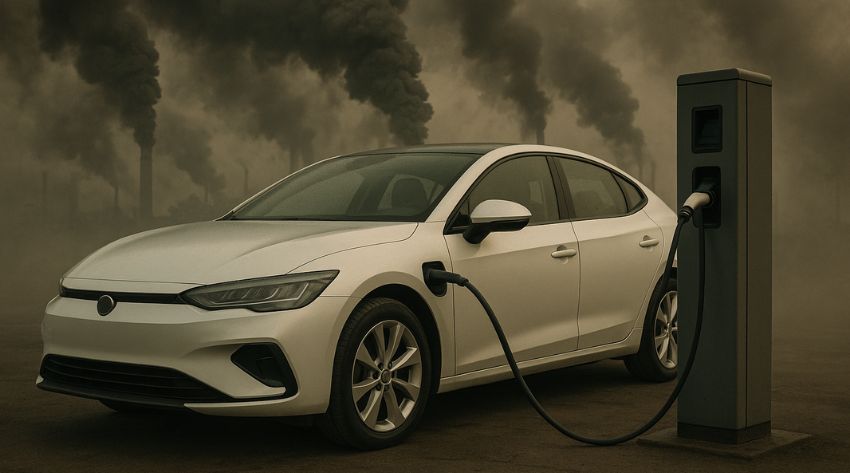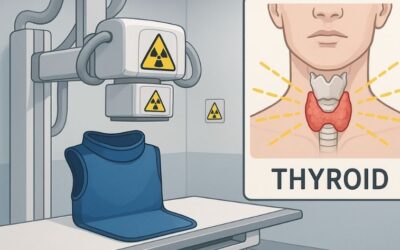When we think of electric vehicles (EVs), we usually picture a cleaner, greener future—zero exhaust, lower emissions, and a break from the fossil fuel cycle. But a surprising new study out of UCLA just revealed a blind spot in this narrative: the air around EV fast-charging stations may not be as clean as we think.
Researchers took daily measurements of PM2.5—ultrafine particulate matter that penetrates deep into your lungs and bloodstream—at 50 different fast-charging (DCFC) sites across 47 cities in Los Angeles County. What they found should make all of us pause: levels ranged from 7.3 to 39.0 µg/m³, with some locations exceeding the EPA’s “safe” threshold of 9 µg/m³ by more than four times. These ultrafine particles often carry chemical contaminants, which significantly contribute to their toxicity and potential health risks.
To put that in perspective, West Hollywood and Santa Clarita topped the chart with readings of 39 and 34 µg/m³. Even more scenic spots like Santa Monica and Claremont weren’t immune, clocking in at 7.3 and 7.5 µg/m³—still problematic for sensitive individuals.
And here’s the kicker: this pollution isn’t coming from the vehicles themselves. It’s coming from the charging equipment.
The cabinets that convert electricity to power your car often house internal cooling systems—fans that circulate air to keep the machines from overheating. But in doing so, they stir up dust, heavy metals, and industrial residue that’s been accumulating inside those enclosures. Once released, those tiny particles become airborne toxins we unknowingly breathe in while waiting for our cars to charge. These airborne toxins can also include volatile organic compounds, which are known to contribute to indoor and outdoor air pollution and may pose additional health risks. Long-term exposure to these toxins and chemicals has been linked to increased cancer risk and other forms of harm, highlighting the importance of understanding and minimizing the toxicity of air around charging stations.
The Rise of Electric Cars: A Quick Introduction
The world is experiencing a rapid transformation as electric cars take center stage in the push for cleaner transportation. From city streets to suburban driveways, electric vehicles like the Tesla Model 3 and Model Y are becoming a common sight, celebrated for their efficiency, lower emissions, and reduced reliance on fossil fuels. Governments and automakers are investing billions in the production of electric cars, aiming to create a future where vehicles are not only more efficient but also less harmful to the environment.
But as the number of electric cars on the road grows, it’s important to look beyond the obvious benefits. The production of electric vehicles and the infrastructure needed to support them—like EV chargers—can introduce new health and environmental challenges. While electric cars are designed to reduce the toxic substances associated with traditional engines, the process of manufacturing, charging, and maintaining these vehicles can still impact our health and the environment in ways that are only now coming to light. Particulate matter is one of the pollutants that can be released during these processes, contributing to air quality concerns.
What Are Toxins, and Why Should You Care?
Toxins are harmful, often poisonous substances produced by living organisms such as plants, bacteria, and animals. These naturally occurring toxins are often referred to as biotoxins, and can include a wide range of harmful compounds. A poison is any substance—whether produced naturally by living organisms or artificially created—that can cause disease or damage when absorbed, inhaled, or ingested, often at very low doses. While all toxins are poisons, not all poisons are classified as toxins, as some may be synthetic or enter the body through different routes.
These natural toxins can be found in a surprising range of foods and environments—think of the cyanide in certain beans, the toxins produced by bacteria in contaminated fish, or the defense chemicals that plants produce to ward off insects. A wide variety of species, including algae, bacteria, and plants, produce toxins that can contaminate both fresh water and marine environments, leading to the presence of toxins in foods such as shellfish and honey. While these substances serve a natural defense mechanism in the wild, they can pose a health risk to humans and animals if consumed or encountered in high levels. For example, honey can be contaminated with plant-derived toxins when bees collect nectar from certain species.
But toxins aren’t just limited to what’s found in nature. The production of electric cars and their batteries can also introduce toxic substances into the environment. Heavy metals and chemicals used in manufacturing, such as lead and cadmium, can be released during production or disposal, potentially contaminating soil, water, and even the air we breathe. Understanding where these toxins come from and how they affect our bodies is crucial for protecting our health, our food supply, and the environment as we transition to new technologies like electric vehicles.
Types of Toxic Substances in Electric Vehicles
One of the most significant concerns is the presence of heavy metals such as lead, mercury, and cadmium, which are commonly used in the production of electric car batteries. These substances are not only toxic but can also accumulate in the environment over time, increasing the risk of harmful exposure through ingestion or contact.
Beyond heavy metals, electric cars also incorporate various chemicals and plastics during manufacturing. Certain types of these materials can release toxic substances, especially if the vehicle is damaged or improperly disposed of. For example, the engine, fuel tank (in plug-in hybrids), and even the seats can harbor chemicals that may be harmful if they leach into the air or water.
Microorganisms are another hidden threat. In the moist, enclosed spaces of a car—such as the ventilation system or upholstery—bacteria and other microorganisms can thrive. Some of these bacteria are capable of producing toxins, including those that can cause cyanide poisoning. In severe cases, exposure to these toxins can lead to disease, organ damage (especially to the liver), or even death.
It’s important to recognize that these toxic substances are not unique to electric vehicles, but the shift to electric power does not eliminate the risk. As electric cars become more common, understanding the range of harmful chemicals, heavy metals, and microorganisms present in these vehicles is essential for protecting your health and the health of those around you.
Why PM2.5 and Toxic Substances Are a Big Deal
These microscopic particles are among the most dangerous air pollutants. PM2.5 and similar airborne pollutants can have significant health impacts. They bypass your body’s natural defenses and burrow deep into lung tissue and blood vessels, triggering inflammation, oxidative stress, heart disease, asthma, and even neurological disorders. PM2.5 can enter the body not only through inhalation but also via skin contact or accidental ingestion, increasing the range of possible symptoms. Symptoms of exposure can include respiratory issues, skin irritation, gastrointestinal problems, or infection if particles are ingested. And if you’re already vulnerable—whether you’re managing chronic illness, have kids, or spend time outdoors—you’re more likely to feel the effects.
How Do EV Chargers Release Toxins? (Causes You Didn’t Expect)
It might come as a surprise, but EV chargers themselves can be a source of toxic substances. During the charging process, these stations can emit particulate matter and volatile organic compounds (VOCs) into the air. These emissions may originate from the charger’s internal components or from the electricity generation process that powers the vehicle. For example, if the electricity comes from a power plant that burns fossil fuels, additional pollutants can be released into the environment.
The story doesn’t end there. The production of EV chargers and electric cars often involves the use of hazardous materials like lead and cadmium. If these substances are not handled or disposed of properly, they can leach into the soil and water, creating long-term environmental and health risks. Even the recycling of EV batteries, which is essential for sustainability, can result in the release of toxic substances such as lithium and nickel if not managed with care. These hidden sources of contamination highlight the importance of responsible production, maintenance, and disposal practices in the electric vehicle industry.
The EMF Factor: Invisible Radiation from Electric Cars and Chargers
There’s another silent stressor hiding in plain sight near your EV: electromagnetic fields (EMFs). While PM2.5 and chemical toxins are now part of the conversation, few people are talking about the growing concern of EMF radiation exposure—and it matters, especially if you already deal with chronic inflammation, autoimmune issues, or chemical sensitivity.
Every electric vehicle, charging station, and high-voltage battery emits EMFs during use. Unlike mechanical combustion engines, EVs rely on powerful electric currents and high-frequency circuitry that generate non-ionizing radiation—the same type of radiation emitted by cell phones and Wi-Fi routers, but often at much higher and more sustained levels.
When you’re sitting in your car for extended periods—especially while it’s charging—you’re being bathed in EMFs that penetrate tissues and may disrupt cellular signaling, mitochondrial function, and even hormone balance. This is especially concerning for people with Hashimoto’s, adrenal fatigue, or thyroid conditions, as EMFs have been shown in some studies to interfere with endocrine function and amplify autoimmune flares.
Charging stations add another layer of exposure. Not only do they emit EMFs from the cables and inverters, but the high-powered current used in fast-charging stations produces intense localized radiation fields, which can be absorbed by the body—especially when standing close to the charger or sitting inside the vehicle during charging.
Some of the documented side effects of chronic EMF exposure include:
- Headaches, fatigue, and brain fog
- Sleep disruption and melatonin suppression
- Elevated cortisol and stress response
- Increased permeability of the blood-brain barrier
- Accelerated aging and oxidative stress
While the debate around EMF safety is ongoing, the precautionary principle applies. We simply don’t yet know the long-term health effects of sustained, high-voltage EMF exposure from electric cars and chargers—especially when combined with air pollution and industrial toxins.
Assessing Health Risk: What Does Science Say About EV Toxins?
The question of how much risk toxic substances in electric vehicles actually pose is still being explored by scientists and health experts. Some research suggests that the levels of toxins found in electric cars are relatively low and may not present an immediate health risk to most people. However, other studies caution that long-term exposure to certain types of natural toxins and toxic substances—whether produced during manufacturing, released from batteries, or introduced by microorganisms—can have harmful effects on both human and animal health.
The production and disposal of electric cars also raise concerns about environmental contamination. If heavy metals or other toxic chemicals are not managed responsibly, they can leach into water sources, affecting animal health and potentially entering the human food chain. This highlights the importance of efficient production methods, regular vehicle maintenance, and responsible waste management to minimize the risk of exposure to harmful substances.
As electric vehicles continue to gain popularity, it’s crucial for manufacturers, regulators, and consumers to stay informed about the potential health risks associated with toxic substances. By prioritizing safe practices and monitoring for contaminants, we can help ensure that the transition to electric cars benefits both our health and the environment.
Technological Advancements: Can Innovation Make EVs Safer?
The electric vehicle industry is rapidly evolving, and with it comes a wave of technological advancements designed to make electric cars not only more efficient but also safer for humans and the environment. Modern electric cars now feature advanced battery management systems that closely monitor temperature and performance, significantly reducing the risk of overheating and the accidental release of toxic substances. These systems help prevent dangerous chemical reactions that could otherwise lead to fires or the emission of harmful chemicals.
In addition to smarter electronics, manufacturers are integrating natural defense mechanisms into vehicle design. Features like firewalls and heat shields act as barriers, protecting both the car’s occupants and the surrounding environment from potential hazards. These innovations are crucial in minimizing the health risks associated with toxic substances that can be produced during battery malfunctions or accidents.
Excitingly, researchers are also exploring the use of certain types of plants that naturally produce toxins—such as cyanogenic glycosides—as inspiration for new, safer battery materials. By harnessing the unique properties of these natural toxins, scientists hope to develop batteries that are less likely to cause cyanide poisoning or other toxic exposures if damaged. This approach could lead to electric vehicles that are not only more efficient but also pose a lower health risk to humans and animals.
As technology continues to advance, we can expect electric cars and their components to become even safer, with fewer harmful chemicals and a reduced environmental footprint. These innovations are paving the way for a new generation of vehicles that prioritize both performance and the well-being of people and the planet.
Industry Response: How Automakers and Charging Companies Are Addressing Toxins
Automakers and charging companies are stepping up to tackle the challenge of toxic substances in the electric vehicle ecosystem. Many leading manufacturers are now prioritizing the use of environmentally friendly and recycled materials in their vehicles, which helps reduce the introduction of new harmful substances into the environment. For example, by incorporating recycled plastics and metals, companies are not only cutting down on waste but also minimizing the need for raw materials that may contain toxic chemicals.
Charging companies are also making strides by investing in renewable energy sources like solar and wind power to generate the electricity that fuels electric vehicles. This shift away from fossil fuels means fewer toxic substances are released into the air, water, and soil, creating a healthier environment for humans, animals, and plants alike.
Beyond the vehicles themselves, some automakers are partnering with organizations dedicated to improving the safety of the food supply. These collaborations focus on removing toxins from food products and monitoring for contaminants that could affect both human and animal health. By addressing the broader impact of toxic substances—from production to power generation to food safety—the industry is demonstrating a commitment to holistic health and environmental stewardship.
These efforts show that the move toward electric vehicles is about more than just cleaner transportation; it’s about creating a safer, more sustainable world for everyone.
Regulatory Framework: Who’s Protecting Your Health?
When it comes to safeguarding public health from natural toxins and toxic substances, a network of organizations and government agencies is working behind the scenes to keep our food supply and environment as safe as possible. The World Health Organization (WHO) plays a leading role in evaluating the health risks posed by natural toxins found in foods and plants, offering guidance on what levels are considered safe for human consumption. Their work is supported by the Joint FAO/WHO Expert Committee on Food Additives (JECFA), which conducts in-depth risk assessments of specific natural toxins—like cyanogenic glycosides in certain beans or furocoumarins in vegetables—to set maximum tolerable intake levels.
In the United States, the Food and Drug Administration (FDA) is responsible for monitoring the food supply for toxic substances, including mycotoxins produced by fungi and poisonous compounds found in some wild mushrooms. The FDA sets regulations to limit exposure to these harmful substances and provides resources, such as the Bad Bug Book, to help consumers and industry professionals understand the risks associated with natural toxins in foods.
Across the Atlantic, the European Food Safety Authority (EFSA) also plays a crucial role. EFSA conducts scientific risk assessments and offers guidance on the safe consumption of foods that may contain natural toxins, such as plants that produce solanines or chaconine. By establishing clear safety standards and monitoring for contaminants, these organizations help protect our health from the wide range of toxic substances that can occur naturally in foods and the environment.
Public Awareness: Are You in the Know About EV Toxins?
Staying informed about natural toxins and toxic substances—especially those linked to electric cars and their components—is more important than ever for protecting both human health and the environment. While electric vehicles are often seen as a cleaner, more efficient alternative to traditional cars, they can still pose risks if not properly managed. For example, the fuel tank and battery systems in electric vehicles may contain toxic substances like lead and cadmium. If these chemicals are released during production, maintenance, or disposal, they can harm humans, animals, and the broader environment.
The production of electric cars also involves the use of various chemicals and materials that, if mishandled, can contaminate soil and water. This is why it’s essential for consumers to be aware of the potential health risks associated with these substances and to follow recommended maintenance and disposal procedures. Supporting companies that prioritize sustainable production and responsible sourcing can further reduce the risk of toxic substances entering our environment.
By understanding the potential dangers and taking proactive steps—such as choosing efficient vehicles, properly disposing of old batteries, and advocating for cleaner production methods—consumers can help minimize harm to themselves, their families, and the planet. Public awareness is a powerful tool in driving the shift toward safer, more sustainable transportation solutions, ensuring that the benefits of electric cars don’t come at the expense of our health or the environment.
The Environmental Impact: Are We Trading One Problem for Another?
Switching to electric cars is widely seen as a step toward a cleaner, greener planet. By reducing tailpipe emissions, electric vehicles help cut down on air pollution and greenhouse gases. However, the environmental story is more complex when you consider the entire lifecycle of electric cars and their charging infrastructure. The production of electric vehicles and EV chargers can release toxic substances into the environment, from the mining of raw materials to the manufacturing process itself.
Take lithium, for example—a key ingredient in EV batteries. Extracting lithium can lead to water pollution and soil contamination, affecting both local ecosystems and human health. Similarly, the disposal of used batteries poses a significant challenge. If not properly recycled, batteries can leak toxic chemicals like lead and cadmium, contaminating landfills and water supplies. These issues raise important questions about whether we’re simply replacing one set of environmental problems with another.
To truly benefit from the promise of electric cars, it’s essential to adopt efficient, sustainable practices throughout the entire production and disposal process. By focusing on responsible sourcing, cleaner manufacturing, and safe recycling, we can minimize the release of toxic substances and ensure that electric vehicles deliver on their promise of a healthier, more efficient future for everyone.
So, What Can You Do About It?
We may not be able to control what’s floating in the air around our cities, but we can protect our bodies from the inside out. That’s where daily detox strategies come into play—and they’re more critical than ever in today’s toxic environment.
Consuming a wide range of nutritious foods, especially those from the Accelerated Food Guide, can support the body’s natural detoxification processes and help reduce the risk of adverse effects from toxin exposure. Effective detox strategies may also include specific treatment protocols to help the body eliminate toxins and maintain optimal health.
Here’s the supplements I recommend to my clients to help detox from PM2.5:
Acceleradine® Iodine – The Master Detox Mineral
Most iodine supplements on the market come in forms your body has to work hard to process—and many are sourced from contaminated regions. Acceleradine® Iodine is entirely different. This is a monoatomic, scalar-charged form of iodine, suspended in 200-proof organic ethyl alcohol, which ensures maximum bioavailability and cellular penetration.
Why does this matter?
- It displaces toxic halogens like fluoride, bromine, and chlorine—many of which bind to iodine receptors in the thyroid and other tissues, effectively blocking detox and energy production.
- It helps restore optimal thyroid function, which governs metabolism and the body’s natural ability to filter and eliminate toxins.
- It activates mitochondrial function, giving every cell more energy to repair and detox at a deeper level.
In the context of PM2.5 and industrial pollution, iodine becomes your first line of defense, binding to halogens and other toxins and initiating cellular repair where other supplements can’t reach.
Accelerated NucNoMore® – Quantum Detox at the Frequency Level
Toxins don’t just have physical weight—they carry harmful frequencies that disrupt cellular communication and energy flow. Accelerated NucNoMore® is designed to neutralize those frequencies, working at the quantum level to erase the “energetic imprint” left by environmental toxins, radiation, EMFs, and heavy metals.
What sets it apart?
- It helps reset the body’s natural detox blueprint, supporting a return to cellular balance.
- It offers critical protection from non-physical exposures—like those from EMFs or radioactive isotopes that piggyback on pollution.
- It enhances your body’s ability to identify and clear toxins that traditional binders might miss.
If you’re being exposed to the invisible side of pollution—especially near industrial infrastructure like EV charging stations—NucNoMore® may add a layer of protection that’s often overlooked but vitally important.
Accelerated Cellular Detox Powder®– Your Nightly Purge of Airborne Toxins
Every night while you sleep, your body shifts into repair mode—and this is the perfect time to flush out the toxins you’ve accumulated throughout the day. Accelerated Cellular Detox Powder® is a potent, scalar-charged blend of six organic binders that trap and eliminate a wide spectrum of pollutants, including:
- Heavy metals
- Mycotoxins
- Pesticides
- Industrial chemicals
- Airborne particulates like PM2.5
What makes it special is the synergy of ingredients: activated charcoal to trap gasses and chemicals, micronized zeolite to bind metals, slippery elm and triphala to soothe the gut and reduce inflammation, and chitosan to carry out excess cholesterol and dietary fat.
This isn’t a harsh cleanse. It’s a gentle, consistent detox that works silently in the background—like a filter for your bloodstream.
Accelerated Liver Care® – Regenerate Your Body’s Central Filter
The liver is your body’s command center for detoxification—but in today’s world, it’s under constant siege. Airborne pollutants, synthetic chemicals, alcohol, pharmaceuticals, and hormone disruptors all pass through your liver daily. Over time, this burden leads to sluggish bile flow, poor fat digestion, hormonal imbalances, and toxic buildup.
Accelerated Liver Care® is a comprehensive, scalar-enhanced herbal formula made with 13 meticulously selected ingredients that address all angles of liver health:
- TUDCA (Tauroursodeoxycholic acid) supports bile flow and cellular repair
- Phyllanthus and Jin Qian Cao protect liver cells and improve enzyme function
- Skullcap and Pau Pereira help reduce inflammation and oxidative stress
- Eclipta, Andrographis, and Thai black ginger support mitochondrial energy and digestion
Most importantly, it’s free from sulfur, oxalates, and common allergens, making it gentle even for sensitive individuals.
With consistent use, Accelerated Liver Care® helps your liver:
- Filter out fine particulates and industrial toxins
- Regenerate damaged tissue
- Restore energy production and hormonal balance
When your liver is truly supported, every other detox pathway—from lymph to kidneys to skin—works more efficiently. You don’t just detox better—you feel better.
Detoxing Isn’t a Trend—It’s a Survival Strategy
In a world where “clean” energy still comes with hidden pollutants, your best protection isn’t just what you avoid—it’s how well your body can adapt and eliminate what shouldn’t be there.
Supporting your thyroid, liver, mitochondria, and cellular integrity daily is no longer optional—it’s essential.
Daily Detox Routine Essentials
• Acceleradine® Iodine
• Accelerated NucNoMore®
• Accelerated Cellular Detox Powder®
• Accelerated Liver Care®
• Accelerated Microplastics Detox Kit
Let your detox work as hard as your environment does.
Electric Cars and Emissions: The Unseen Pollutants
Electric cars are often celebrated for their ability to reduce air pollution and cut down on harmful emissions in our cities. But while these vehicles may not emit exhaust from a tailpipe, the story doesn’t end there. The production of electric cars involves extracting and processing metals like lithium and cobalt—substances essential for powerful batteries but potentially harmful to the environment and animal health. For example, mining these metals can lead to water pollution, soil contamination, and the release of toxic substances that affect both local ecosystems and the people who depend on them. The body and environment have natural mechanisms to rid themselves of toxins, but these processes can be overwhelmed by high levels of exposure.
The electricity that powers electric vehicles is another piece of the puzzle. If the electricity comes from fossil fuel sources, it can still contribute to air pollution by releasing particulate matter, nitrogen oxides, and other harmful chemicals into the environment. These pollutants don’t just disappear—they can travel long distances, affecting air quality and posing health risks to humans and animals alike. Medicine plays a crucial role in treating or mitigating the effects of toxin exposure.
Beyond chemical pollutants, the shift to electric vehicles can also influence the spread of certain types of microorganisms. For instance, the increased use of water in battery production and cooling systems can create environments where bacteria and other microorganisms thrive. Some of these bacteria are capable of producing toxins that may harm animal health or even enter the human food chain, especially if water sources become contaminated. Some toxins, especially those produced by microorganisms, can affect the nervous systems of humans and animals.
It’s clear that while electric cars offer many benefits, they are not entirely free from environmental and health concerns. Understanding the full lifecycle of these vehicles—from raw material extraction to electricity generation and eventual disposal—helps us make informed choices and encourages the development of cleaner, safer technologies for the future.
Navigating the Road Ahead
As we look to the future, it’s important to recognize that natural toxins and toxic substances are a part of our everyday lives, whether they come from the foods we eat, the cars we drive, or the environment we live in. Plants produce toxins as a natural defense mechanism against insects and other threats, and while these substances can protect the plant, they may be harmful to humans if consumed in high levels. Our liver works tirelessly to filter out these toxins from the bloodstream, but excessive exposure—whether from food products, environmental pollutants, or even efficient new technologies like electric cars—can overwhelm this vital organ.
Electric cars represent a major step forward in reducing our reliance on fossil fuels and improving air quality, but they also introduce new challenges related to the production and release of toxic substances. By staying informed about the potential risks and benefits, we can make smarter choices for our health and the environment. This means paying attention to the foods we eat, supporting sustainable agriculture, and choosing products that minimize our exposure to harmful substances.
Nutrition plays a key role in supporting the body’s natural detoxification processes, and a balanced diet can help protect against the effects of toxins. At the same time, investing in renewable energy and cleaner technologies can help reduce the overall burden of pollution on our environment and our bodies.
Ultimately, creating a healthier, more sustainable future requires a collective effort—from individuals making conscious choices, to communities advocating for safer practices, to governments enacting policies that protect both human and animal health. By working together and staying proactive, we can ensure that the benefits of innovation, like electric cars, are realized without compromising our well-being or the health of our planet.
Sara Banta
Sara Banta is a Stanford University Graduate with a Degree in Economics and Psychology, and a certified Natural Supplement Expert & Graduate of the Institute for Integrative Nutrition. Sara is the Founder of Accelerated Health Products and host of the health & wellness podcast, Accelerated Health Radio.
- Sara Bantahttps://sarabantahealth.com/author/sarabanta/
- Sara Bantahttps://sarabantahealth.com/author/sarabanta/
- Sara Bantahttps://sarabantahealth.com/author/sarabanta/
- Sara Bantahttps://sarabantahealth.com/author/sarabanta/









